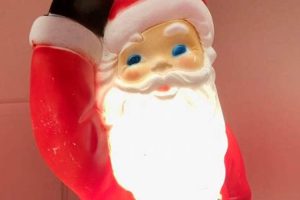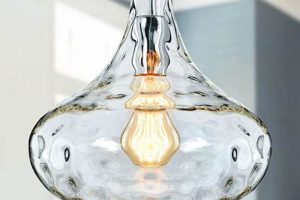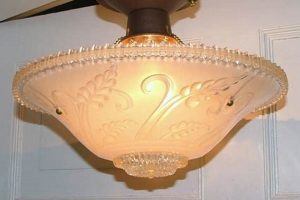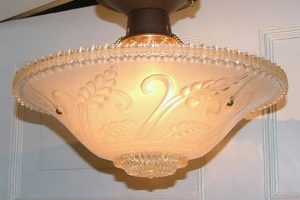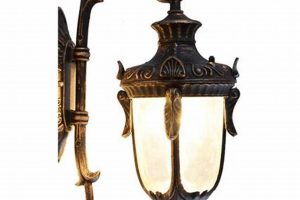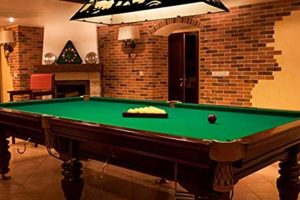Electroluminescent diodes replicating the aesthetic of older holiday illumination systems are increasingly prevalent. These modern interpretations of classic Christmas lighting utilize light-emitting diodes to emulate the look and feel of traditional incandescent bulbs commonly used in past decades. A typical application involves decorating Christmas trees or outdoor spaces with these energy-efficient and visually appealing light sources.
The incorporation of light-emitting diode technology offers numerous advantages over traditional incandescent versions. These include significantly reduced energy consumption, extended lifespan, and enhanced durability. Furthermore, the cooler operating temperature of light-emitting diodes minimizes the risk of overheating and potential fire hazards. The nostalgic visual appeal combined with the practical benefits has led to increased adoption for both residential and commercial holiday displays.
The subsequent sections will delve into the specific characteristics, advantages, purchasing considerations, and maintenance practices associated with these unique holiday lighting solutions. We will explore the variations available, optimal usage scenarios, and factors influencing longevity and performance.
Tips for Selecting and Maintaining LED Vintage Christmas Lights
Optimizing the performance and longevity of these decorative light sources requires careful consideration of various factors during selection and maintenance. The following tips offer guidance for achieving optimal results.
Tip 1: Verify Ingress Protection (IP) Rating: When intended for outdoor use, confirm the lights possess an adequate IP rating, indicating resistance to water and dust ingress. This precaution safeguards against premature failure due to environmental exposure. For example, an IP44 rating provides protection against splashing water.
Tip 2: Inspect Wire Gauge and Insulation: Examine the wire gauge and insulation quality. Thicker gauge wiring and robust insulation contribute to enhanced durability and reduced risk of electrical issues, particularly in colder temperatures where insulation can become brittle.
Tip 3: Assess Light Source Quality: Scrutinize the light source’s color temperature and consistency. Discrepancies in color temperature can detract from the desired aesthetic. Reputable manufacturers typically provide specifications regarding color temperature consistency.
Tip 4: Implement Proper Storage Procedures: During off-season storage, carefully wind the strands to prevent tangling and potential damage to the delicate light-emitting diodes. Utilize a storage container that shields the lights from direct sunlight and extreme temperature fluctuations.
Tip 5: Conduct Periodic Inspections: Before each use, thoroughly inspect the strands for any signs of damage, such as frayed wires, cracked bulbs, or loose connections. Address any identified issues promptly to prevent potential hazards.
Tip 6: Utilize Surge Protection: Consider employing surge protectors to safeguard the lights from voltage spikes, which can damage the internal circuitry of the light-emitting diodes. This is particularly relevant in areas prone to electrical storms.
Effective implementation of these measures enhances the visual appeal, extends the operational lifespan, and ensures the safe utilization of light-emitting diode vintage holiday lighting.
The concluding section will synthesize the information presented and reiterate the key advantages and considerations associated with the selection and utilization of these lighting systems.
1. Efficiency
The integration of light-emitting diode technology represents a significant advancement in energy efficiency within the context of vintage-style holiday lighting. Unlike traditional incandescent bulbs, these systems offer a substantial reduction in energy consumption, impacting both operational costs and environmental footprint.
- Energy Consumption Reduction
Light-emitting diodes consume a fraction of the energy required by incandescent bulbs to produce comparable light output. This translates to lower electricity bills for consumers and reduced demand on power grids during peak holiday seasons. For example, a string of LED vintage lights might consume 80-90% less energy than an equivalent incandescent string.
- Heat Generation Minimization
Traditional incandescent bulbs generate significant heat as a byproduct of light production, wasting energy and posing potential fire hazards. Light-emitting diodes, conversely, operate at much cooler temperatures, minimizing energy waste and reducing the risk of overheating. This cooler operation also contributes to a longer lifespan for the lighting system.
- Lifespan Extension
The extended lifespan of light-emitting diodes contributes indirectly to overall efficiency. Infrequent replacements reduce waste and minimize the energy and resources associated with manufacturing and disposal. Some light-emitting diode vintage-style lights boast lifespans exceeding 25,000 hours, significantly outlasting incandescent alternatives.
- Cost Savings Over Time
While the initial purchase price of light-emitting diode vintage holiday lighting may be higher than incandescent options, the long-term cost savings due to reduced energy consumption and less frequent replacements typically offset this initial investment. Consumers experience a lower total cost of ownership over the lifespan of the lighting system.
The enhanced efficiency inherent in light-emitting diode technology, when applied to vintage-style Christmas lights, provides a compelling combination of aesthetic appeal and practical benefits. The reduced energy consumption, cooler operation, and extended lifespan contribute to a more sustainable and cost-effective holiday lighting solution.
2. Aesthetics
Aesthetics represent a critical component in the appeal of light-emitting diode vintage Christmas lights. The primary objective of these lighting systems is to replicate the visual characteristics of traditional incandescent bulbs while leveraging the efficiency and longevity of light-emitting diode technology. The success of this emulation directly influences consumer perception and market adoption. Imperfect color rendering, uneven light distribution, or discrepancies in bulb shape can detract from the desired vintage aesthetic and diminish the product’s overall value.
The chromatic properties of the light-emitting diodes are paramount. Many seek the warm, soft glow characteristic of older incandescent bulbs, often measured in Kelvin (K). Light-emitting diodes with a color temperature around 2700K typically emulate this warmth effectively. Furthermore, bulb shape and size influence the aesthetic authenticity. Manufacturers often replicate the classic shapes of C7 or C9 bulbs. For instance, a lighting system employing oversized, multi-faceted light-emitting diodes with a warm color temperature closely mimics the appearance of traditional holiday lights, enhancing the visual experience.
Ultimately, the aesthetic fidelity of light-emitting diode vintage Christmas lights determines their success in evoking nostalgia and creating a festive atmosphere. Deviations from established aesthetic norms can lead to consumer dissatisfaction. The combination of energy efficiency and visual authenticity makes the use of these products a more sought-after choice. Manufacturers are continuously refining light-emitting diode technology to further enhance chromatic accuracy and visual similarity to legacy lighting systems, increasing the value of the product.
3. Durability
Durability is a crucial performance characteristic determining the longevity and sustained functionality of light-emitting diode vintage Christmas lights. Resistance to environmental factors, physical stress, and degradation over time directly influences the cost-effectiveness and user satisfaction associated with these products. Robust construction and quality materials are essential for ensuring that these lighting systems withstand the rigors of seasonal use and storage.
- Material Composition and Construction
The materials employed in the construction of light-emitting diode vintage Christmas lights significantly impact their overall durability. High-quality polymers used for bulb housings and weather-resistant coatings on wiring contribute to protection against UV radiation, moisture, and physical impacts. For instance, using a UV-stabilized polycarbonate for the bulb housing prevents yellowing and cracking over time, extending the product’s lifespan.
- Weather Resistance and Ingress Protection
For outdoor applications, effective weather resistance is paramount. Light-emitting diode vintage Christmas lights should possess an adequate Ingress Protection (IP) rating, indicating their ability to withstand exposure to water and dust. An IP44 rating, for example, signifies protection against splashing water, while higher ratings offer greater protection against submersion. This protection prevents corrosion of electrical components and maintains functionality in adverse weather conditions.
- Light-Emitting Diode Lifespan and Degradation
The inherent lifespan of the light-emitting diodes themselves contributes significantly to the overall durability of the lighting system. High-quality light-emitting diodes exhibit minimal light output degradation over time, maintaining consistent brightness and color temperature throughout their operational life. Reputable manufacturers provide data on the lumen maintenance of their light-emitting diodes, indicating the expected light output after a specified number of operating hours.
- Wiring and Connection Integrity
The integrity of the wiring and electrical connections is crucial for preventing failures and ensuring safe operation. Durable wiring with robust insulation and secure connections can withstand repeated handling and flexing during installation and storage. For example, using thicker gauge wiring with reinforced insulation reduces the risk of wire breakage and short circuits, contributing to the overall durability and safety of the lighting system.
The integration of these durable components and construction techniques directly influences the long-term performance and reliability of light-emitting diode vintage Christmas lights. By prioritizing durability in design and manufacturing, producers enhance product value and reduce the environmental impact associated with frequent replacements. Furthermore, a focus on robust materials and weather resistance ensures safe and reliable operation in diverse environmental conditions.
4. Safety
The integration of light-emitting diode (LED) technology into vintage Christmas lights presents inherent safety advantages compared to traditional incandescent bulbs. A primary concern with older lighting systems was the elevated operating temperature of incandescent bulbs, posing a significant fire hazard, particularly when in proximity to dry Christmas trees or flammable decorations. LEDs, conversely, generate minimal heat, substantially reducing the risk of ignition. This cooler operation is a direct consequence of the energy-efficient nature of LEDs, where a larger proportion of electrical energy is converted into light rather than heat. Real-world examples document instances where incandescent holiday lights have ignited dry foliage, resulting in property damage and potential injury. The lower heat output of LED vintage Christmas lights mitigates this risk significantly, contributing to a safer holiday environment. Therefore, electrical safety is paramount to ensure the integrity of the lights.
Further safety considerations extend to the electrical characteristics of LED vintage Christmas lights. Many modern LED systems operate at lower voltages compared to traditional incandescent circuits, reducing the potential for electrical shock. Additionally, the robust construction and durable materials used in many LED vintage light strings enhance their resistance to damage and degradation over time. For example, reinforced insulation and secure connections minimize the risk of short circuits and electrical arcing. These improvements in electrical safety standards represent a substantial advancement over older lighting systems, providing consumers with a more reliable and secure holiday lighting solution. Also, proper outdoor rated or indoor rated are essential for lighting safety.
In conclusion, the adoption of LED technology in vintage Christmas lights has demonstrably enhanced safety profiles. The reduced heat generation, lower operating voltages, and improved construction standards contribute to a safer holiday lighting experience. While inherent risks remain, careful adherence to manufacturer’s guidelines and periodic inspection of lighting systems are essential for maximizing safety and minimizing the potential for accidents. The practical significance of understanding these safety advantages lies in making informed purchasing decisions and promoting responsible usage of holiday lighting systems, for the greatest safety in home.
5. Authenticity
The connection between authenticity and light-emitting diode (LED) vintage Christmas lights centers on the degree to which these modern lighting systems accurately replicate the aesthetic qualities of traditional incandescent holiday lights. Authenticity, in this context, is not simply about mimicking the outward appearance; it encompasses the nuanced characteristics of light emission, bulb shape, and overall visual effect. The cause-and-effect relationship is evident: greater authenticity results in a more compelling and nostalgic visual experience, directly influencing consumer satisfaction and market demand. Achieving authenticity presents a technical challenge, requiring careful selection of LED components and innovative design to emulate the warm glow and distinctive filament appearance of vintage bulbs. For instance, some manufacturers employ specialized LED chips with lower color temperatures and diffuse lenses to mimic the soft, amber light characteristic of early Christmas lights.
The importance of authenticity lies in its ability to evoke a sense of nostalgia and tradition, core elements of the holiday season. Many consumers seek to recreate the visual atmosphere of past Christmases, relying on vintage-style lights to achieve this effect. A lack of authenticity, characterized by harsh, overly bright light or inaccurate bulb shapes, can undermine this desired ambiance. Practical applications of this understanding extend to product development and marketing strategies. Manufacturers prioritize accurate color rendering index (CRI) values and adherence to vintage bulb dimensions to enhance authenticity. Marketing campaigns emphasize the nostalgic appeal, highlighting the ability of the lights to transport consumers back to simpler times. For example, one manufacturer advertises its “Edison-style” LED Christmas lights, showcasing their warm glow and classic filament design, which directly target consumers seeking an authentic vintage aesthetic.
Challenges in achieving authenticity include replicating the subtle variations in light output and color temperature inherent in vintage incandescent bulbs. Furthermore, maintaining energy efficiency and durability while prioritizing aesthetic accuracy presents a design trade-off. In conclusion, the authenticity of LED vintage Christmas lights is a crucial determinant of their market success and ability to deliver a genuine holiday experience. By prioritizing accurate replication of vintage aesthetics, manufacturers can cater to consumer demand for nostalgic lighting solutions, effectively bridging the gap between modern technology and cherished holiday traditions.
Frequently Asked Questions about LED Vintage Christmas Lights
This section addresses common inquiries and misconceptions regarding light-emitting diode (LED) vintage Christmas lights, providing clear and concise answers to assist consumers in making informed decisions.
Question 1: Are LED vintage Christmas lights truly energy efficient?
Yes, LED vintage Christmas lights are significantly more energy efficient than traditional incandescent bulbs. They consume up to 80-90% less energy while producing comparable light output.
Question 2: Do LED vintage Christmas lights generate heat?
No, LED vintage Christmas lights generate very little heat compared to incandescent bulbs. This reduces the risk of fire hazards and makes them safer to use around flammable materials.
Question 3: How long do LED vintage Christmas lights typically last?
LED vintage Christmas lights typically last much longer than incandescent bulbs. Many models boast lifespans of 25,000 hours or more, reducing the need for frequent replacements.
Question 4: Are LED vintage Christmas lights suitable for outdoor use?
Some LED vintage Christmas lights are specifically designed and rated for outdoor use. It is essential to verify the Ingress Protection (IP) rating to ensure adequate resistance to water and dust.
Question 5: Do LED vintage Christmas lights accurately replicate the look of traditional Christmas lights?
The authenticity varies depending on the manufacturer and design. High-quality LED vintage Christmas lights effectively mimic the warm glow and bulb shape of traditional incandescent bulbs.
Question 6: Are LED vintage Christmas lights more expensive than traditional Christmas lights?
The initial purchase price may be higher, but the long-term cost savings from reduced energy consumption and longer lifespan typically offset this initial investment.
LED vintage Christmas lights offer a compelling combination of energy efficiency, longevity, safety, and aesthetic appeal. Consumers can leverage these advantages by carefully selecting models that meet their specific needs and preferences.
The following section provides guidance on selecting the right LED vintage Christmas lights for different applications and decorating styles.
Concluding Observations on LED Vintage Christmas Lights
The preceding analysis elucidates key attributes of led vintage christmas lights. Efficiency gains, aesthetic considerations, durability factors, safety enhancements, and degrees of authenticity all converge to define the overall value proposition. A comprehensive understanding of these elements allows for informed decision-making when selecting and deploying these lighting systems.
The ongoing evolution of light-emitting diode technology suggests further refinements in efficiency, aesthetic accuracy, and longevity. Prudent evaluation of product specifications and adherence to safety guidelines will remain paramount in maximizing the benefits and mitigating potential risks associated with led vintage christmas lights during future holiday seasons. The responsible application of this technology offers a pathway towards sustainable and visually compelling holiday illumination.


